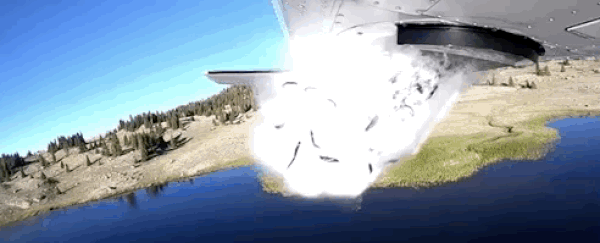If you happen to be visiting one of Utah's many remote mountain lakes, don't be alarmed if you suddenly see more fish in the sky than in the water.
It's not a trick of the eye. It's the state's latest attempt at trout restoration.
The US state of Utah is well-known for excellent trout fishing in high mountain lakes. But keeping these remote lakes open for fishing all year round requires periodic re-population.
In the good old days, this meant loading up a metal milk can with trout, and then transporting the fish via horse to the isolated bodies of water.
Today, the state has settled on a much faster and safer solution, called "extreme fish stocking", and it's every bit as radical as it sounds.
Last week, the Utah Division of Wildlife Resources (DWR) posted a video of the practice on its social media accounts. The unbelievable footage features a tumbling mass of trout falling out of a plane and into the waiting lake below.
"Fun fact," the agency wrote on Twitter, "We stock many of Utah's high-mountain lakes from the air. The fish are tiny — anywhere from 1–3 inches [roughly 2 to 7 cm] long — which allows more than 95 percent of them to survive the fall".
Fun fact: We stock many of Utah's high-mountain lakes from the air. The fish are tiny — anywhere from 1–3 inches long — which allows more than 95% of them to survive the fall. #Utah #TroutTuesday pic.twitter.com/kotDe91Zzw
— UtahDWR (@UtahDWR) August 21, 2018
This may seem like a cruel practice, but trout are built to be the ultimate adrenaline junkies.
Because the fish are so tiny, and because their bodies are perfectly streamlined and lightweight, they are able to survive massive falls with little to no harm.
Even in nature, these fish are able to skyrocket over a waterfall and live to tell the tale. In fact, scientists estimate that 90 percent of fish in the Niagara river are able to survive the 50 metre-drop (165 feet) over Niagara Falls.
By netting a bunch of the trout after the aerial plunge, DWR has made sure that their estimates of survival are correct.
When the planes fly as low as possible, the new aerial method is far less stressful for the trout than transporting them via land, which takes multiple days and requires constant monitoring of oxygen levels.
Because of their small size (reduced mass), the process of dropping doesn’t hurt the fish. Think of it as a high diver diving into a deep pool of water.
— UtahDWR (@UtahDWR) August 22, 2018
Nowadays, the state is using this mind-boggling technique to stock more than 200 of Utah's remote alpine lakes with hybrid trout called splake (Salvelinus fontinalis) and Arctic grayling trout (Thymallus arcticus).
The fish are sterilised beforehand so that they do not mess with the population of native species.
"Give us a heads up before transplanting any moose or antelope," one user joked on Facebook.
